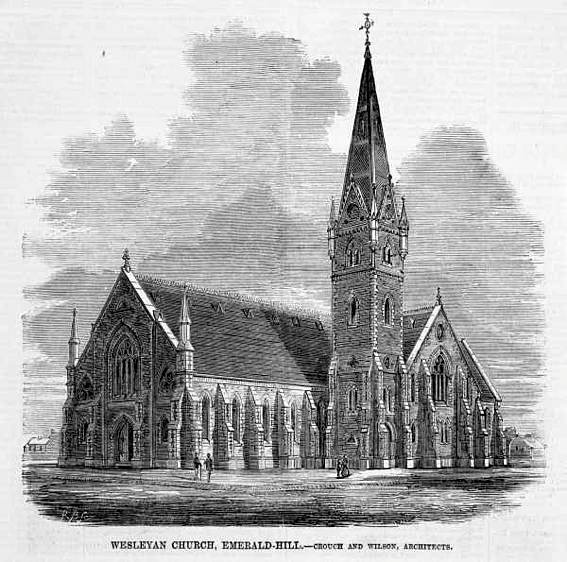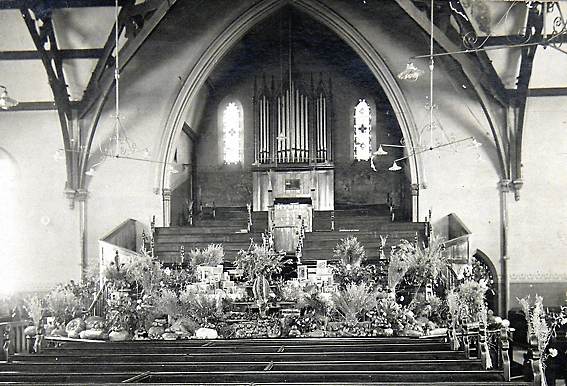
Wesleyan (Methodist) Church, South Melbourne: exterior view showing the proposed tower and spire
(Illustrated Australian News 12 October 1868)

Wesleyan (Methodist) Church, South Melbourne: exterior view showing the proposed tower and spire
(Illustrated Australian News 12 October 1868)
Historical and Technical Documentation by John Maidment
© OHTA, 2013 (last updated April 2013)

Methodist Church, South Melbourne: interior view showing the organ
after the extension of the choir seating
(photograph in the Uniting Church Archives, Elsternwick)
The Wesleyan Church in South Melbourne was a splendid bluestone building placed on a prominent site at the corner of Cecil and Dorcas Streets. Sadly, as the churchgoing population of the area declined, the congregation amalgamated with the Presbyterian Church net door and it was closed in 1965 and the building later demolished.
LAYING THE FOUNDATION STONE OF A WESLEYAN CHURCH, EMERALD-HILL.
Yesterday afternoon His Excellency the Governor laid the foundation-stone of a new Wesleyan church in Cecil-street, Emerald-hill. The congregation have been for some time worshipping in the wooden schoolhouse on the church reserve, and latterly in the hall of the Mechanics' Institute, and it having been thought advisable to enter upon the construction of a more suitable building, a very neat design by Messrs. Crouch and Wilson, architects, was adopted. The church will be 72ft. long, by 40ft. in width, and it is expected will be completed before Christmas next.1
WESLEYAN CHURCH, EMERALD HILL.
The ceremony of laying the foundation stone of considerable additions to the Wesleyan Church on Emerald-hill was performed by the President of the Conference yesterday afternoon, at five o'clock, in the presence of a large number of the congregation and their friends. In the course of the ceremony a very handsome silver trowel, manufactured by Mr. Edwards, of Collins-street, and bearing an appropriate inscription, was handed to the rev. gentleman. The present additions comprise a transept (18ft. x40ft., with orchestra, vestries, etc, at the rear, the whole to be built of bluestone, with pressed cement dressings, and in style similar to the nave already built. There will, be two additional entrances on the north and south sides, making in all five, exclusive of the separate entrances to the orchestra. The old building is one of the earliest instances of the free introduction of pressed cement by way of dressings, and we are glad to learn has given great satisfaction. The completed design includes a tower and spire at the intersection of the transept and nave, and the walls of the porch in that position are being put in sufficiently heavy to carry the same. The leaden box which was deposited under the stone contained a parchment scroll, with the following inscription : "This scroll was deposited beneath the foundation-stone of transept additions to Wesleyan Church, Emerald-hill, when laid by the Rev. James Bickford, President of the Australasian Wesleyan Methodist Conference, on Thursday, the 6th day of February, A.D. 1868, in the thirty-first year of the reign of Her Most Gracious Majesty Queen Victoria, His Excellency Sir Jno. H. T. Manners Sutton, K.C.B., being Governor-in-Chief, Captain-General, and Vice-Admiral of the colony of Victoria ; the ministers of the circuit (Melbourne First) being Revs. John Cope, Joseph Albiston, W. D. Mclean, and Henry Moore; Church Building Committee : Rev. Joseph Albiston and Mr. John Bee (treasurers) ; Messrs. D. H. Beresford, W. N. Blair, James Brooke, Alexander Brown, John Colclough, John Danks, John Elder, Robert Fairbridge, Robert Macgregor (secretary), John B. Nicholson, Harold Rayson, J. Tulloch, George Wharton, Charles P. Woodfin ; architects, Messrs. Crouch and Wilson ; builders, Messrs. Holroyd and Ravenscroft. The foundation stone of the nave of this church was laid by Sir H Barkly on the 11th day of August, A.D. 1863, and the church opened on the 6th March, 1864." Also, with the scroll, copy Minutes of Conference, 1867 ; List of Stations, 1868; Annual Address of Conference, 1868. Printed on parchment :-Plan of Appointments for the Circuit; copy Wesleyan Chronicle 20th January, 1868 ; copies of The Argus, Age, and Herald, 6th February, 1868."2
The new organ was described in The Argus:
A tea-meeting was held lost evening on the occasion of the opening of the new organ, which has been built by Mr. Fincham, of Richmond, for the Emerald-hill Wesleyan congregation. Tea was served in the school- room adjoining the church, and the company which sat down was one of the largest which ever assembled at Emerald-hill on a similar occasion. After tea, a concert of sacred music was given in the church. The building, which has sittings for nearly a thousand persons, was well filled, and the admission fees, together with the collection made during the evening, must have afforded a handsome sum towards reducing the debt existing on the organ. In the interval between the two parts of the programme, Mr, Watkins, the pastor of the church, addressed the audience. He stated that the organ had cost about £400, and towards reducing this amount £51 had already been collected. The concert itself was one of the most agreeable features of the evening's proceedings. The programme was confined to selections of sacred music, and included some of the most celebrated arias and choruses of Handel and Mendelssohn. Among the singers present were Mesdames Fox and Schaw, and Messrs. Exon, Madden, and A. Ford. Mr. G. R. G. Pringle presided at the organ, and Mr. Thos Ford acted as conductor. In Batiste's Andante in G, and in the Grand-Offertoire in D Major by the same master, Mr. Pringle was very successful in developing the fine qualities of the instrument over which he presided. The accompaniments to some of the choruses, although given with his usual taste and efficiency, were not, of course, so effective, as the instrument is too small to afford the necessary power and volume of sound which they require. Mrs. Fox's aria, "Hear ye, Israel,"from "Elijah,"was much applauded ; and Mrs. Schaw, although rather nervous, gave Mendelssohn's air, "But the Lord is mindful of his own," with sweetness and expression, Mr. Madden, who also lacks confidence, and who was on that account less effective than he might have been, sang Haydn's well-known air, "In native worth,"' with considerable taste. Mr. Exon was in fine voice, and his recitative, "Comfort ye my people," followed by the air, "Every valley shall be exalted," was perhaps the most successful performance of the evening. The recitative was especially well given, and it was a pity that Mr. Ford so hurried the following chorus that the audience had scarcely time to reward Mr. Exon's efforts with the applause they merited. The chorus, which was composed of the church choir, supplemented by a few extra voices, did the work allotted to it with praise- worthy vigour and unison, and showed that a great deal of preparatory training and rehearsal had been undertaken by its conductor, Mr. Thos. Ford.3

Methodist Church, South Melbourne: interior view showing the organ,
taken earlier than the above illustration,
before the choir seating was extended forwards into the church
(photograph in the Uniting Church Archives, Elsternwick)
The organ was built in 1869 by George Fincham. In 1887, the Keraulophon was taken from the Great and placed in the position of a Trumpet on the Swell, and a Dulciana added in place of the Keraulophon, this work carried out by Fincham. In 1903, Geo. Fincham & Son constructed new soundboards, new feeders, a Clarinet was added to the Swell Organ, the Twelfth altered to a Celeste, and the bottom octave of the Oboe added; the console was also extended forward by six feet. In 1906, the Clarinet was moved to the Great, a Clarion added to the Swell in place of the Clarinet, and a Harmonic Flute substituted for an earlier Clear Flute on the Great.4
The specification of this instrument, noted shortly before its removal from the church, was:
| GREAT Open Diapason Clarabella Dulciana Principal Flute Fifteenth Trumpet Clarionet Swell to Great SWELL Double Diapason Open Diapason Stopped Diapason Keraulophon Celeste Principal Piccolo Oboe Clarion PEDAL Open Diapason Great to Pedal Swell to Pedal |
8 8 8 4 4 2 8 8 16 8 8 8 8 4 2 8 4 16 |
TC TC TC |
Compass: 56/29
Mechanical key and stop action
Spotted metal pipework5
The organ was removed from the church in 1965 and the parts rebuilt by Laurie Pipe Organs Pty Ltd for Zion Lutheran Church, Walla Walla, NSW.
1 The Argus 12 August 1863, p.3
2 Ibid., 7 February 1868, p.6
3 Ibid., 21 July 1869, p.5
4 E.N. Matthews, Colonial Organs and Organbuilders (Carlton: Melbourne University Press, 1969), pp.151-2 citing George Fincham letters
5 Specification noted by Robert Heatley 1965